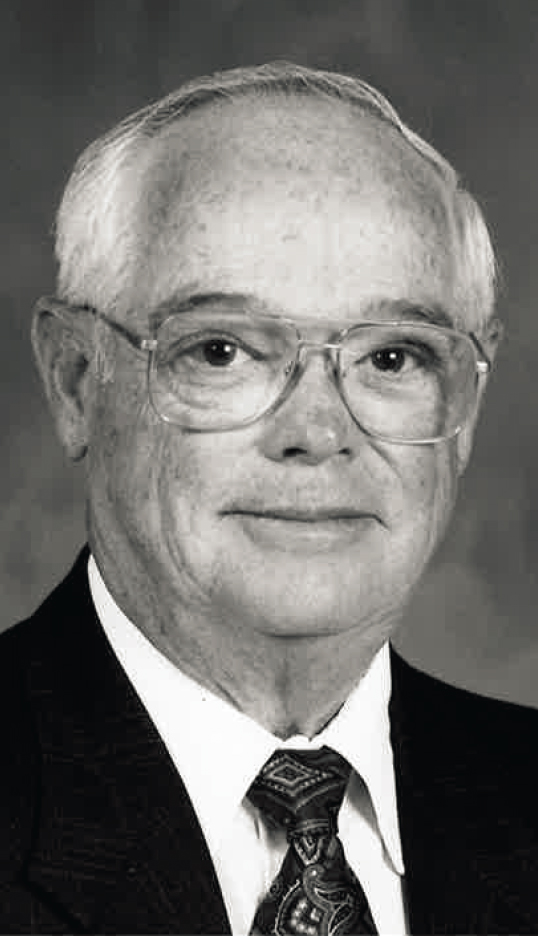
THOMAS L. HAMPTON
1931–2017
Elected in 1997
“For contributions to design of large aircraft engines.”
BY JAN C. SCHILLING
THOMAS LEE HAMPTON loved the aviation industry and spent his career advancing the state of the art of aircraft engine design and structural integrity. He passed away October 4, 2017, at the age of 86, in Jupiter, Florida.
Tom was born January 24, 1931, in Covington, Kentucky. He received a bachelor of science degree in aeronautical engineering from the University of Notre Dame in 1952 and a master of science in aerospace engineering from the University of Cincinnati in 1968.
He started his career in 1952 at McDonnell Aircraft and then in 1955 joined General Electric Aircraft Engines in Evendale, Ohio. During his 26 years at GE, he progressed from working as a structural designer to managing a number of units: Advanced Structures, Advanced Fans and Compressors, GE F101 Hot Section, and, finally, Energy Efficient Engine.
In 1981 he moved to Pratt & Whitney Government Properties Division of United Technologies Corporation as director of propulsion technology and chief engineer. In 1989 he became director of engine design and chief engineer responsible for military aircraft and rocket mechanical design and technology. Upon retiring from P&W in 1993, he became an independent consultant in engine design until 2002.
Tom’s professional experiences spanned concept to production to fielded engines. At GE he developed structural analysis methods for determining the axial stiffness of strutted frames and for variable vane actuation systems. These methods were used during the early days of modern jet engine design, until the development of modern computational methods. Under Tom’s leadership of the Advanced Fan and Compressors unit, a Kevlar fan blade containment case was developed for the CF6-80 engine, which reduced containment structural weight and all major structural components, including aircraft mounting, that are limited by a blade release event.
At P&W Tom made a number of significant contributions. He conceived unique structural designs in support of the F100-PW-229 increased thrust engine for installation on F-16 and F-15 aircraft. He supported the redesign of the F100-PW-220 compressor variable stator vane actuation system to reduce hysteresis and wear, enabling the engine to achieve both operability and durability requirements. He directed the turbomachinery structural design configuration of the F119-PW-100 advanced tactical fighter engine for F-22 aircraft, resulting in fewer turbomachinery stages, bearing compartments, and frames, leading to reduced weight and cost.
Tom was an excellent mentor for young engineers. He always approached designs or problems with designs using engineering first principles. He maintained a positive attitude even in exceptionally challenging situations. In the early years of component design, general design rules were not as established as they are today. If there was a failure, Tom would look at it as a learning experience and make it a priority not to repeat the mistake by documenting the learning in the company’s design practices. This was done at both GE and P&W for frame structures, engine mounting, stator case construction, and variable stator actuation systems.
In addition to his NAE membership, he was an associate fellow of the American Institute of Aeronautics and Astronautics (AIAA) and a member of SAE. He served on the Air Force Ordinance and Propulsion Committee (1997), Air Force Research in Aero Propulsion Technology Advisory
Board (1984–92; chair, 1989), and University of Florida Engineering Advisory Council. In retirement, he was a consultant to the USAF Independent Review Team for the F119 engine and USAF Materials Lab, and chair of the F119 Fan Blade Independent Review Team and the Integrated High-Performance Turbine Engine Technology Industry Panel. Tom had several publications through AIAA/SAE/ASME related to the design and durability of engines.
Well recognized for his knowledge and approach to solving problems, Tom was sought after as a chief engineer and consultant, positions that require one to maintain engineering integrity and product safety at the highest level and to work with diverse internal and external experts. His topnotch technical mind, credibility, and demeanor were ideally suited to these roles.
In retirement Tom enjoyed travel, boating, and gardening.
His wife Edith (née Archambeult) predeceased him in 2006. They were married for 53 years and are survived by their two children, Kathy Lynn Neuman (of Cincinnati) and Kevin Lee Hampton (of Covington, KY), seven grandchildren, and nine great-grandchildren.




